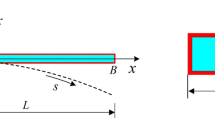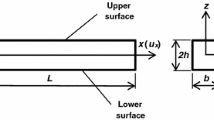Abstract
Nanobeams have promising applications in areas such as sensors, actuators, and resonators in nanoelectromechanical systems (NEMS). Considering the effects of gyration inertia, surface layer mass, surface residual stress, and surface Young’s modulus, this study develops the vibration equations of the Timoshenko nanobeam. The generalized differential quadrature (GDQ) method and molecular dynamics (MD) simulation are used to study the surface effect on vibration. For a rectangular cross section, surface residual stress and surface Young’s modulus are all affected by the height of the cross section rather than by the length–height ratio. If surface layer mass is considered, then the first three natural frequencies all decrease relative to their counterparts in the case in which surface layer mass is ignored. Results show that the effect of gyration inertia on resonance frequency is negligible. Longitudinal vibration does not easily occur relative to the bending and rotation vibrations of nanobeams. In addition, the results obtained by the GDQ method fit those obtained by MD simulation for beams with length–height ratios of 4–8. This study provides insights into the mechanism of the vibration of short and deep nanobeams and sheds light on the quantitative design of the elements in NEMSs.












Similar content being viewed by others
Availability of data and materials
Not applicable.
Code availability
Not applicable.
References
Wang ZL (2000) Nanomaterials for nanoscience and nanotechnology. In: Wang ZL (ed) Charaterization of nanophase materials. Wiley, Weinheim
Frank S, Poncharal P, Wang ZL et al (1998) Carbon nanotube quantum resistors. Science 280:1744–1746
Wang Q, Arash B (2014) A review on applications of carbon nanotubes and graphenes as nano-resonator sensors. Comput Mater Sci 82:350–360
Eltaher MA, Agwa MA, Mahmoud FF (2016) Nanobeam sensor for measuring a zeptogram mass. Int J Mech Mater Des 12:211–221
Tang HL, Shen ZB, Li DK (2014) Vibration of nonuniform carbon nanotube with attached mass via nonlocal Timoshenko beam theory. J Mech Sci Technol 28(9):37413747
Aydogdu M (2009) A general nonlocal beam theory: Its application to nanobeam bending, buckling and vibration. Physica E 41:1651–1655
Barretta R, Feo L, Luciano R et al (2016) Functionally graded Timoshenko nanobeams: a novel nonlocal gradient formulation. Compos Part B-Eng 100:208–219
Robinson MTA, Adali S (2018) Buckling of nonuniform and axially functionally graded nonlocal Timoshenko nanobeams on Winkler-Pasternak foundation. Compos Struct 206:95–103
Rouhi H, Ebrahimi F, Ansari R et al (2019) Nonlinear free and forced vibration analysis of Timoshenko nanobeams based on Mindlin’s second strain gradient theory. Eur J Mech A Solid 73:268–281
Simsek M, Yurtcu HH (2013) Analytical solutions for bending and buckling of functionally graded nanobeams based on the nonlocal Timoshenko beam theory. Compos Struct 97:378–386
Thai HT (2012) A nonlocal beam theory for bending, buckling, and vibration of nanobeams. Int J Eng Sci 52:56–64
Wang LF, Hu HY (2005) Flexural wave propagation in single-walled carbon nanotubes. Phys Rev B 71:195412
Jiang JN, Wang LF, Zhang YQ (2017) Vibration of single-walled carbon nanotubes with elastic boundary conditions. Int J Mech Sci 122:156–166
Li C, Yao LQ, Chen WQ et al (2015) Comments on nonlocal effects in nano-cantilever beams. Int J Eng Sci 87:47–57
Zhan HZ, Yang FP, Wang X (2018) Nonlinear dynamic characteristics of bi-graphene sheets/piezoelectric laminated films considering high order van der Walls force and scale effect. Appl Math Model 56:289–303
Eltaher MA, Abdelrahman AA, Al-Nabawy A et al (2014) Vibration of nonlinear graduation of nano-Timoshenko beam considering the neutral axis position. Appl Math Comput 235:512–529
Zarepour M, Hosseini SAH, Akbarzadeh AH (2019) Geometrically nonlinear analysis of Timoshenko piezoelectric nanobeams with flexoelectricity effect based on Eringen’s differential model. Appl Math Model 69:563–582
Gurtin ME, Murdoch AI (1978) Surface stress in solids. Int J Solids Struct 14:431–440
Wang GF, Feng XQ (2009) Surface effects on buckling of nanowires under uniaxial compression. Appl Phys Lett 94:141913
Zhao DM, Liu JL, Wang L (2016) Nonlinear free vibration of cantilever nanobeam with surface effects: semi-analytical solutions. Int J Mech Sci 113:184–195
Jalaei MH, Arani AG, Nguyen-Xuan H (2019) Investigation of thermal and magnetic field effects on the dynamic instability of FG Timoshenko nanobeam employing nonlocal strain gradient theory. Int J Mech Sci 161–162:105043
Ansari R, Gholami R, Sahmani S (2011) Free vibration analysis of size-dependent functionally graded microbeams based on the strain gradient Timoshenko beam theory. Compos Struct 94:221–228
Chen W, Wang L, Dai HL (2019) Stability and nonlinear vibration analysis of an axially loaded nanobeam based on nonlocal strain gradient theory. Int J Appl Mech 11(7):1950069
Wang J, Shen HM, Zhang B et al (2018) Studies on the dynamic stability of an axially moving nanobeam based on the nonlocal strain gradient theory. Mod Phys Lett B 32:1850167
Attia MA, Shanab RA, Mohamed SA et al (2019) Surface energy effects on the nonlinear free vibration of functionally graded Timoshenko nanobeams based on modified couple stress theory. Int J Struct Stab Dyn 19(11):1950127
Trabelssi M, El-Borgi S, Fernandes R et al (2019) Nonlocal free and forced vibration of a graded Timoshenko nanobeam resting on a nonlinear elastic foundation. Compos Part B Eng 157:331–349
Jazi AJ, Shahriari B, Torabi K (2017) Exact closed form solution for the analysis of the transverse vibration mode of a Nano-Timoshenko beam with multiple concentrated masses. Int J Mech Sci 131–132:728–743
Arefi M, Pourjamshidian M, Arani AG et al (2019) Influence of flexoelectric, small-scale, surface and residual stress on the nonlinear vibration of sigmoid, exponential and power-law FG Timoshenko nanobeams. J Low Freq Noise V A 38(1):122–142
Jiang LY, Yan Z (2010) Timoshenko beam model for static bending of nanowires with surface effects. Physica E 42:2274–2279
Yang LH, Fan T, Yang LP et al (2017) Bending of functionally graded nanobeams incorporating surface effects based on Timoshenko beam model. Theor Appl Mech Lett 7:152–158
Hashemian M, Foroutan S, Toghraie D (2019) Comprehensive beam models for buckling and bending behavior of simple nanobeam based on nonlocal strain gradient theory and surface effects. Mech Mater 139:103209
Ansari R, Mohammadi V, Faghih Shojaei M et al (2014) Nonlinear vibration analysis of Timoshenko nanobeams based on surface stress elasticity theory. Eur J Mech A Solid 45:143–152
Hosseini SAH, Rahmani O (2016) Free vibration of shallow and deep curved FG nanobeam via nonlocal Timoshenko curved beam model. Appl Phys A Mater 122:169
Zhao DM, Hao P, Wang JW et al (2020) Surface effects on the quasi-periodical free vibration of the nanobeam: semi-analytical solution based on the residue harmonic balance method. Meccanica 55:989–1005
Mi C, Jun S, Kouris DA et al (2008) Atomistic calculations of interface elastic properties in noncoherent metallic bilayers. Phys Rev B 77:075425
Shenoy VB (2005) Atomistic calculations of elastic properties of metallic FCC crystal surfaces. Phys Rev B 71:094104
Jia N, Yao Y, Yang YZ et al (2017) Surface effect on the resonant frequency of Timoshenko nanobeams. Int J Mech Sci 133:21–27
Lu P, He LH, Lee HP et al (2006) Thin plate theory including surface effects. Int J Solids Struct 43:4631–4647
Ansari R, Faghih Shojaei M, Mohammadi V et al (2014) Nonlinear forced vibration analysis of functionally graded carbon nanotube-reinforced composite Timoshenko beams. Compos Struct 113:316–327
Cammarata RC (1994) Surface and interface stress effects in thin films. Prog Surf Sci 46(1):1–38
Ru CQ (2010) Simple geometrical explanation of Gurtin–Murdoch model of surface elasticity with clarification of its related versions. Sci China Phys Mech 53(3):536–544
Foiles SM, Baskes MI, Daw MS (1986) Embedded-atom-method functions for the fcc metals Cu, Ag, Au, Ni, Pd, Pt, and their alloys. Phys Rev B 33(12):7983–7991
Plimpton S (1995) Fast parallel algorithms for short-range molecular dynamics. J Comput Phys 117:1–19
Funding
This study was supported by the National Natural Science Foundation of China (Grand Number 11672334).
Author information
Authors and Affiliations
Corresponding author
Ethics declarations
Conflict of interest
The authors declare that they have no conflicts of interest.
Ethics approval
All the authors agree to the ethics approval.
Consent to participate
Not applicable.
Consent for publication
All the authors consent to publication.
Appendices
Appendix A
In Eqs. (23–25) of Sect. 2, parameters \(a_{11}\), \(a_{12}\), \(a_{21}\), \(a_{22}\), \(a_{23}\), \(a_{24}\), \(a_{31}\),\({ }a_{32}\), \(a_{33}\), \(a_{34}\), \(a_{35}\), \(a_{36}\), and \(a_{37}\) are provided as
Appendix B
In Sect. 3, the procedure to compute the weighting coefficients of the first and higher-order derivatives based on the GDQ method are written as
Appendix C
In Sect. 3, the process to compute the matrices M, K, and N using the GDQ method can be described as
where
The operation symbol \(\circ\) represents the Hadamard product.
The Hadamard and Kronecker Products are as follows.
Definition 1
Hadamard product.
Let
The Hadamard product expressed in matrix form is
Based on the GDQ method, the computation of the weighting coefficients of the first- and higher-order derivatives is
Definition 2
Based on the trapezoidal rule, the integral matrix operators are.
where \({\varvec{X}} = \left\{ {x_{1} ,x_{2} , \ldots ,x_{N} } \right\}\), \({\varvec{F}} = \left\{ {f\left( {x_{1} } \right),f\left( {x_{2} } \right), \ldots ,f\left( {x_{N} } \right)} \right\}^{{\text{T}}}\),\(\varvec{S}_{{\varvec{x}}} = \left\{ {{\varvec{S}}_{{\varvec{x}}} } \right\}_{1 \times N} = \frac{1}{2}{\varvec{XW}}\)
Rights and permissions
About this article
Cite this article
Zhao, D., Wang, J. & Xu, Z. Surface Effect on Vibration of Timoshenko Nanobeam Based on Generalized Differential Quadrature Method and Molecular Dynamics Simulation. Nanomanuf Metrol 4, 298–313 (2021). https://doi.org/10.1007/s41871-021-00117-3
Received:
Revised:
Accepted:
Published:
Issue Date:
DOI: https://doi.org/10.1007/s41871-021-00117-3




